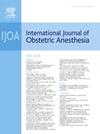鞘内右美托咪定用于剖宫产:范围回顾
IF 2.3
3区 医学
Q2 ANESTHESIOLOGY
引用次数: 0
摘要
背景:最近的剖宫产疼痛管理指南中建议使用鞘内右美托咪定(ITDex)。本次范围审查的主要目的是确定所有报道ITDex用于剖宫产的出版物,其次是评估证据并描述与使用ITDex相关的报告结果。方法根据PRISMA-Scr指南,我们于2024年10月检索PubMed和Embase中关于ITDex用于剖宫产的文章,并对随机对照试验(RCTs)和观察性试验进行了范围综述。制定了包含7个研究特征问题和13个临床结果评估问题的图表数据。结果我们检索了2015年至2024年10月期间的48篇英文出版物:43项随机对照试验,3项观察性试验,2例病例报告/系列,共有2,002例患者接受了ITDex(剂量范围为1-35 μg)。31项(65%)研究报告了主要结局。有7项剂量范围研究,1项与芬太尼共给药,1项与吗啡共给药,3项比较ITDex与可乐定(可乐定剂量范围15 ~ 75 μg);35例报告了颤抖,36例报告了阻滞特征(发病和阻滞持续时间),38例评估了术后镇痛,9例报告了剖宫产时的疼痛。右美托咪定可能是一种有价值的剖宫产鞘内辅助剂,但48篇出版物的研究设计和数据报告的质量非常差。虽然我们确定了43项随机对照试验,其中至少有一只手臂接受ITDex治疗,但没有研究纳入目前的多模式阿片类镇痛方案(鞘内芬太尼和吗啡加或不加右美托咪定),因此存在重大的知识空白。本文章由计算机程序翻译,如有差异,请以英文原文为准。
Intrathecal dexmedetomidine for cesarean delivery: a scoping review
Background
Off-label use of intrathecal dexmedetomidine (ITDex) is suggested in recent guidelines for pain management during cesarean delivery. The primary objective of this scoping review was to identify all publications reporting on ITDex for cesarean delivery, and secondarily to evaluate the evidence and characterize reported outcomes associated with its use.
Methods
Following PRISMA-Scr guidelines, we searched PubMed and Embase in October 2024 for articles reporting on ITDex for cesarean delivery and conducted a scoping review on randomized controlled trials (RCTs) and observational trials. A chart data with seven questions characterizing the studies and 13 evaluating clinical outcomes was developed.
Results
Our search identified 48 publications in English between 2015 and October 2024: 43 RCTs, three observational trials, two case reports/series, resulting in 2,002 patients receiving ITDex (dose ranging 1–35 . Primary outome was stated in 31 (65 %) studies. There were seven dose-ranging studies, one study with fentanyl co-administration, none with morphine co-administration, three compared ITDex vs. clonidine (clonidine dose ranging 15–75 ; 35 reported on shivering, 36 on block characteristics (onset and block duration), 38 evaluated postoperative analgesia, nine reported on pain during cesarean delivery.
Discussion
Dexmedetomidine may be a valuable intrathecal adjuvant for cesarean delivery but the quality of study design and data reporting in the 48 publications was extremely poor. Though we identified 43 RCTs with at least one arm receiving ITDex, no study incorporated current multimodal opioid-sparing analgesia regimens (administration of intrathecal fentanyl and morphine with or without dexmedetomidine), therefore significant knowledge gaps remain.
求助全文
通过发布文献求助,成功后即可免费获取论文全文。
去求助
来源期刊
CiteScore
4.70
自引率
7.10%
发文量
285
审稿时长
58 days
期刊介绍:
The International Journal of Obstetric Anesthesia is the only journal publishing original articles devoted exclusively to obstetric anesthesia and bringing together all three of its principal components; anesthesia care for operative delivery and the perioperative period, pain relief in labour and care of the critically ill obstetric patient.
• Original research (both clinical and laboratory), short reports and case reports will be considered.
• The journal also publishes invited review articles and debates on topical and controversial subjects in the area of obstetric anesthesia.
• Articles on related topics such as perinatal physiology and pharmacology and all subjects of importance to obstetric anaesthetists/anesthesiologists are also welcome.
The journal is peer-reviewed by international experts. Scholarship is stressed to include the focus on discovery, application of knowledge across fields, and informing the medical community. Through the peer-review process, we hope to attest to the quality of scholarships and guide the Journal to extend and transform knowledge in this important and expanding area.

 求助内容:
求助内容: 应助结果提醒方式:
应助结果提醒方式:


